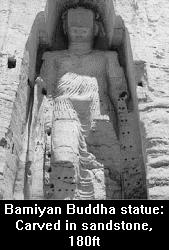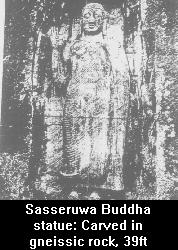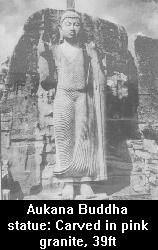
22nd April 2001
News/Comment|
Editorial/Opinion| Business|
Sports| Mirror Magazine

Aukana Buddha based on Bamiyan
By A. Denis N. Fernando
Nearly four decades ago, when I was reading for my post-graduate degree in photogrammetric engineering (aerial surveys) in the Netherlands, it was compulsory for our coursework to prepare different maps using stereo photographs. We had to prepare maps of architectural and archaeological interest as well. For this, I had a choice of architectural monuments in Germany, or archaeological monuments from Afghanistan, or Indonesia. I
chose the Bamiyan Buddha statue for the preparation of the three dimensional
model, as it was similar to our own Aukana Buddha statue at Kalawewa. This
Buddha statue of Afghanistan was about 180ft. in height. And even then
parts of the two hands were damaged, while the face was flaked vertically
due to age. At that time it was not mutilated, but only subjected to weathering.
I
chose the Bamiyan Buddha statue for the preparation of the three dimensional
model, as it was similar to our own Aukana Buddha statue at Kalawewa. This
Buddha statue of Afghanistan was about 180ft. in height. And even then
parts of the two hands were damaged, while the face was flaked vertically
due to age. At that time it was not mutilated, but only subjected to weathering.
Historically, Afghanistan was part of the Persian Empire in the 6th century B.C. and its old Persian (Pahlavi) name was Augan. Subsequently, it was subjected to Greek domination after Alexander the Great conquered it in the 3rd century B.C., which was later overthrown by Parthians and later in the first century by the Kushans who adopted Buddhism.
I had the privilege of visiting the region in Pakistan conquered by Alexander the Great which extended to the Indus valley where there were several cities named after him called Alexandria. While in Afghanistan he also established cities named after him. Alexander or Prince Alexander was known as Skandar Kumar or Al Iskanda in its Arabic form. One such city named after him, now called Kandara, was greatly influenced by Greek art - from which the distinct Gandara art derived its name.
This Indo-Greek art spread along the Silk Route where we see these distinct sculptures, not only in Pakistan, but also in the Bamiyan valley in Afghanistan - which has the famous Buddha statue 180ft. in height in a blessing posture. This art form also percolated to Buddhist countries like Sri Lanka. This form of art is known as Gandara art. Today however, this Bamiyan statue of the Buddha has been destroyed and desecrated by the Taleban.
Since the Bamiyan valley was on the main Silk Route, it also became a centre of Buddhist pilgrimage and was visited by foreign pilgrims. Their visits are recorded in the annals of history.
 The
first attempt to reproduce the sculpture of the Bamiyan Buddha in Sri Lanka
was at Sasseruwa where it was deeply incised into the niche of gneissic
rock. Thirty nine feet high from head to toe, this sculpture was four and
a half times smaller than the original. This was clearly a difficult task
for the sculptor as the rock was not regular and thus was difficult to
carve. Folklore indicates that as the sculptor was not satisfied with the
finish produced a most exquisite Buddha statue on pink granite- which was
also a better stone to sculpt- at Kalawewa, on his second attempt. Both
these sculptures were of the same mudra as is seen in pictures given.
The
first attempt to reproduce the sculpture of the Bamiyan Buddha in Sri Lanka
was at Sasseruwa where it was deeply incised into the niche of gneissic
rock. Thirty nine feet high from head to toe, this sculpture was four and
a half times smaller than the original. This was clearly a difficult task
for the sculptor as the rock was not regular and thus was difficult to
carve. Folklore indicates that as the sculptor was not satisfied with the
finish produced a most exquisite Buddha statue on pink granite- which was
also a better stone to sculpt- at Kalawewa, on his second attempt. Both
these sculptures were of the same mudra as is seen in pictures given.
This three dimensional statue was cut into the pink granite rock and was 39 feet from head to toe. It is clear that the sculptor had used the same measurements for this statue from the original measurements he made at Bamiyan, suitably reduced as the Bamiyan statue was four and a half times larger. It is clear that the Siraspatha of this statue was clearly not part of the living rock, but was a subsequent addition, as could be seen from the picture.
 The
sculpture was so graceful and pleasing that the sculptor gave it the name
- Aukana Buddha. For he had got his inspiration from the Bamiyan Buddha
in Augan, the old Persian word for Afghanistan.
The
sculpture was so graceful and pleasing that the sculptor gave it the name
- Aukana Buddha. For he had got his inspiration from the Bamiyan Buddha
in Augan, the old Persian word for Afghanistan.
I first wrote a short note on the history of the Aukana Buddha statue of Kalawewa in the Mahaweli Magazine over two decades ago connecting it with the sculpture of Afghanistan. But it must be remembered that the Bamiyan statue at Afghanistan is 180ft. while those of Sasseruwa and Kalawewa are 39ft.
(The writer is a Fellow of the National Academy of Sciences)







![]()
Front Page| News/Comment| Editorial/Opinion| Plus| Business| Sports| Mirror Magazine
Please send your comments and suggestions on this web site to

